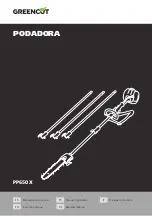
10
installed and grounded in accordance with all local
codes and ordinances.
Do not modify the plug provided - if it will not fit the
outlet, have the proper outlet installed by a qualified
electrician.
Improper connection of the equipment-grounding
conductor can result in a risk of electric shock. The
conductor with insulation having an outer surface
that is green with or without yellow stripes is the
equipment-grounding conductor. If repair or
replacement of the electric cord or plug is
necessary, do not connect the equipment-grounding
conductor to a live terminal.
Check with a qualified
electrician or service pe
r
sonnel if the grounding
instructions are not completely understood, or if
in doubt as to whether the tool is properly
grounded. Failure to comply may cause serious
or fatal injury.
Use only 3-wire extension cords that have 3-prong
grounding plugs and 3-pole receptacles that accept
the tool's plug.
Repair or replace damaged or worn cord
immediately.
This tool is for use on a nominal 120-V circuit, and
has a grounded plug that looks like the plug
illustrated in A, Figure 6-1. A temporary adaptor that
looks like the adaptor illustrated in B and C may be
used to connect this plug to a 2-pole receptacle as
shown in B if a properly grounded outlet is not
available.
The temporary adaptor should be used only until a
properly grounded outlet (A, Figure 6-1) can be
installed by a qualified electrician. The green
colored rigid ear, lug, or the like extending from the
adaptor must be connected to a permanent ground
such as a properly grounded outlet box cover.
Whenever the adaptor is used, it must be held in
place by a metal screw.
In Canada, the use of a temporary adaptor is not
permitted by the Canadian Electrical Code, C22.1.
Figure 6-1: plug configuration
6.4
Extension cords
The use of extension cords is discouraged; try to
position machines near the power source. If an
extension cord is necessary, make sure it is in good
condition. When using an extension cord, be sure to
use one heavy enough to carry the current your
product will draw. An undersized cord will cause a
drop in line voltage resulting in loss of power and
overheating. Table 2 shows correct size to use
depending on cord length and nameplate ampere
rating. If in doubt, use the next heavier gauge. The
smaller the gauge number, the heavier the cord.
Ampere
Rating
Volts
Total length of
cord in feet
More
Than
Not
More
Than
120 25 50 100 150
AWG
0 6 18
16
16 14
6 10
18
16
14 12
10 12 16
16 14 12
12 16 14
12
Not
Recommended
Extension Cord Recommendations
Table 2
7.0
Adjustments
7.1
Removing and installing blades
A general purpose blade has been installed,
tensioned, and tracked on the band saw and should
not require immediate attention. For future blade
replacement, proceed as follows:
1. Disconnect machine from power source.
2. Raise bow enough for blade to clear table slot.
Secure bow position by turning hydraulic switch
to off.
3. Loosen four knobs and open both blade wheel
covers.
4. Remove upper gap cover (A, Figure 7-1, two
knobs) and lower blade guard (B, one screw).
5. Release blade tension by turning blade tension
handle (C) counterclockwise until blade is free.
Figure 7-1: installing blade
6. Back off blade guides (see
sect. 7.5
), and wire
brush.
Содержание HBS-916EVS
Страница 20: ...20 14 1 1 HBS 916EVS 1018EVS Bed and Base Assembly Exploded View...
Страница 21: ...21 14 1 2 HBS 916EVS Bow Assembly Exploded View...
Страница 22: ...22 14 1 3 HBS 1018EVS Bow Assembly Exploded View...
Страница 29: ...29 14 2 1 HBS 916EVS 1018EVS Gear Speed Reducing Box Exploded View...
Страница 31: ...31 15 0 Electrical Connections HBS 916EVS 1018EVS...











































